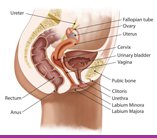Breakdown of the Female Anatomy

Would you consider yourself a pro when it comes to identifying the parts of the female anatomy? Whether or not you'd like to admit it, the answer may be no for most of you. According to the Center for Sexual Health Promotion at Indiana University, only 26 percent of women look closely "down there". And 64% of women "can't pick a cervix out of a lineup", according to the Women's Health-American Congress of Obstetricians and Gynecologists (ACOG) survey. However, it is important to be familiar with what's going on down there so that you can know when things are running smoothly and when they're not. Here's an ultimate guide to your lady bits to keep you happy, healthy, and in-the-know.
Female Anatomy Breakdown
Vagina
"Vagina" is the term most women mistakenly use to label everything going on "down there". In reality, it's just one piece of the puzzle! Your vagina is the "muscular canal that extends from the cervix to the outside of the body" (Medicine Net). It is the passage through which sperm enters the cervix and which blood exits during menstruation. It's also the exit route for the baby during vaginal birth!
Another important thing you should know about your vagina is that pH matters. As with your hair and skin, your vagina has an optimal pH and regular occurrences like your period or intimacy can set it off balance through the introduction of blood and/or semen. A healthy vaginal pH is between 3.5 and 4.5 and studies show that vaginal issues, like vaginal odor, often occur when this pH is unbalanced. Luckily, there are things you can do to help prevent an imbalanced vaginal pH. RepHresh™ Vaginal Gel is clinically shown to maintain healthy vaginal pH, eliminating vaginal odor and relieving feminine discomfort.
Vulva
The vulva is the outer area "down there" which is often incorrectly referred to as the vagina. It includes the clitoris and the labia (Medicine Net).
Labia Majora
The labia majora, part of the vulva, are the larger outside pair of labia (Medicine Net).
Labia Minora
The labia minora, also part of the vulva, are the smaller pair of labia, inside the labia majora. According to Inner Body, the labia minora "function as protective structures that surround the clitoris, urinary orifice, and vaginal orifice". Women may worry about the way their labia minora look, but a woman's labia minora vary quite considerable in length, shape and pigmentation.
Clitoris
Medicine Net defines the clitoris as a "small mass of erectile tissue in the female that is situated at the anterior apex of the vulva". It is grown from the same tissue that makes up the penis. Male and female genitalia both contain a huge number of nerve endings. And, the "clitoris alone has more than 8,000" (Health.com)! No wonder its sole function is pleasure.
Hymen
Many women are familiar with the hymen as being the indicator of virginity, although this claim is widely debated. The hymen is a piece of tissue that lines the vaginal opening and is not actually a good indicator for virginity since it doesn’t always break during one's first time having sexual intercourse (Palo Alto Medical Foundation).
Ovaries
Your ovaries play a major role in the female reproductive system, as this is where your eggs are stored. A woman has two ovaries, each about the size and shape of an almond. The ovaries are responsible for producing eggs and female hormones.
Fallopian Tubes
The Fallopian tubes connect the ovaries and the uterus. They are responsible for carrying eggs from the ovary to the uterus, serving a vital role in conception.
Uterus
Of course many women know the uterus as the source of our pain during that time of the month, but beyond cramps, the uterus serves a very important function. This female reproductive organ holds the baby during pregnancy! According to Healthline, "the uterus is connected to the fallopian tubes, the cervix and (via the cervix) the vagina." It is responsible for nourishing the fetus as it grows.
Cervix
The cervix is a cylinder-shaped neck of tissue connecting the vagina and the uterus. The cervix dilates during childbirth to allow the baby to pass through. It also opens a small amount during menstruation to allow menstrual flow to exit the body (WebMD).
Urethra
Some women do not realize that there is another opening "down there" besides the vagina. The urethra is a very small opening above the vaginal opening, through which urine passes (Medicine Net).
Now that you're educated about the female anatomy, you can share all of your new-found knowledge with your girlfriends! Remember that it is important to be knowledgeable about what goes on down there so that you can recognize any inconsistencies. And with vaginal pH being such an important part of your overall vaginal health, it is good to know when it is off balance. To prevent vaginal odor and maintain your vaginal health, use RepHresh™ Gel. RepHresh Gel doesn't just treat the symptoms, it gets to the cause!
